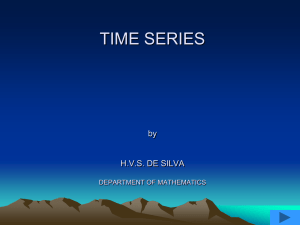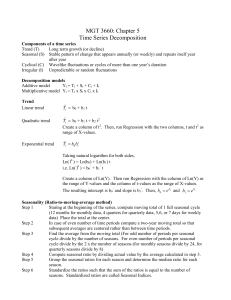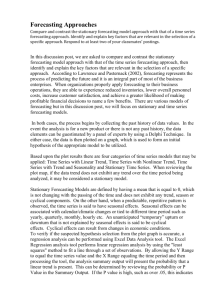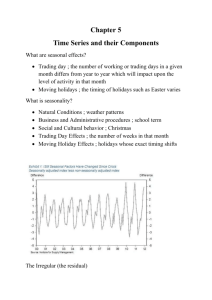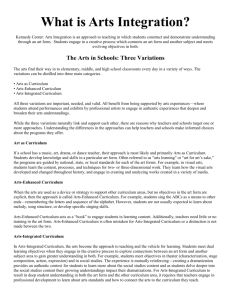Define and/or describe the four components of a time series a. Trend
advertisement
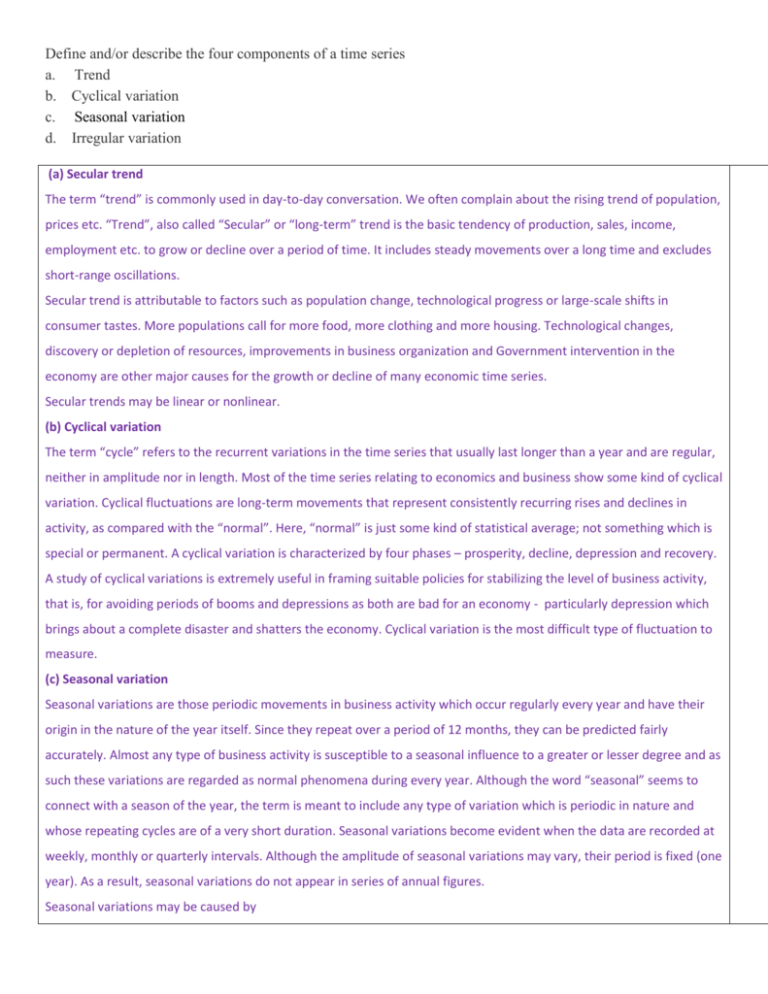
Define and/or describe the four components of a time series a. Trend b. Cyclical variation c. Seasonal variation d. Irregular variation (a) Secular trend The term “trend” is commonly used in day-to-day conversation. We often complain about the rising trend of population, prices etc. “Trend”, also called “Secular” or “long-term” trend is the basic tendency of production, sales, income, employment etc. to grow or decline over a period of time. It includes steady movements over a long time and excludes short-range oscillations. Secular trend is attributable to factors such as population change, technological progress or large-scale shifts in consumer tastes. More populations call for more food, more clothing and more housing. Technological changes, discovery or depletion of resources, improvements in business organization and Government intervention in the economy are other major causes for the growth or decline of many economic time series. Secular trends may be linear or nonlinear. (b) Cyclical variation The term “cycle” refers to the recurrent variations in the time series that usually last longer than a year and are regular, neither in amplitude nor in length. Most of the time series relating to economics and business show some kind of cyclical variation. Cyclical fluctuations are long-term movements that represent consistently recurring rises and declines in activity, as compared with the “normal”. Here, “normal” is just some kind of statistical average; not something which is special or permanent. A cyclical variation is characterized by four phases – prosperity, decline, depression and recovery. A study of cyclical variations is extremely useful in framing suitable policies for stabilizing the level of business activity, that is, for avoiding periods of booms and depressions as both are bad for an economy - particularly depression which brings about a complete disaster and shatters the economy. Cyclical variation is the most difficult type of fluctuation to measure. (c) Seasonal variation Seasonal variations are those periodic movements in business activity which occur regularly every year and have their origin in the nature of the year itself. Since they repeat over a period of 12 months, they can be predicted fairly accurately. Almost any type of business activity is susceptible to a seasonal influence to a greater or lesser degree and as such these variations are regarded as normal phenomena during every year. Although the word “seasonal” seems to connect with a season of the year, the term is meant to include any type of variation which is periodic in nature and whose repeating cycles are of a very short duration. Seasonal variations become evident when the data are recorded at weekly, monthly or quarterly intervals. Although the amplitude of seasonal variations may vary, their period is fixed (one year). As a result, seasonal variations do not appear in series of annual figures. Seasonal variations may be caused by (i) Climate and weather conditions: example, during winter there is a greater demand for woolen cloths whereas in summer, there is a greater demand for cool drinks and ice cream. (ii) Customs, traditions and habits: example, since most students buy books in the first few weeks of the schools and colleges opening, the sale of books and stationery show seasonal swings. (d) Irregular variation Irregular variation, also called “erratic” ”accidental” or “random” variations refer to such variations in business activity which do not repeat in a definite pattern. It includes all types of variations other than trend, seasonal and cyclical movements. The latter three, when they are actually at work, act in such a way as to produce certain systematic effects. Irregular movements on the other hand are largely random, being the result of chance factors. Irregular variations are caused by such isolated special occurrences as floods, earthquakes, strikes and wars. Sudden changes in demand or very rapid technological progress may also be included in this category. Quantitatively it is almost impossible to separate the irregular movements from the cyclical movements. Therefore, in time series analysis the trend and the seasonal variations are measured separately, while the cyclical and irregular variations are accounted together. What is the purpose of forecasting? Why are forecasts not always correct? What are the limitations of forecasting? The sole purpose of forecasting is prediction. Based upon available previous data so as to make an “informed” guess (a forecast) about what is likely to happen in the future. Forecasts can go wrong for several reasons. First of all, all said and done, a forecast is a guess, and as such can go wrong. Forecasts are based on available data, and if the available data is misleading, even the forecast will be. A forecasting model may be inadequate or poorly constructed. Sometimes unexpected errors may creep in resulting in incorrect forecasts. Forecasting is limited by many factors. As said earlier, imperfect information is a major limitation making the whole exercise futile. Inadequacy of mathematical modeling to incorporate all the variables, and time are other limitations. Long term forecasts are even more difficult to make than short term forecasts. Why are simple moving averages and weighted averages commonly used forms of forecasting? Moving averages and weighted averages assist in better forecasting by smoothing the data. By smoothing out the excess variability in the data, it becomes easier to notice the trend in the data (if any). These techniques are simple, yet powerful and economical way of handling an otherwise sporadic data. Therefore, they are commonly used.
